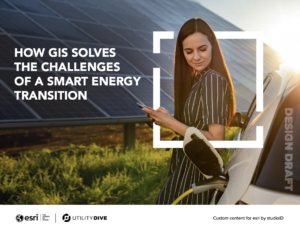Full Title: How GIS Solves the Challenges of a Smart Energy Transition
Author(s): Environmental Systems Research Institute
Publisher(s): Environmental Systems Research Institute
Publication Date: October 29, 2022
Full Text: Download Resource
Description (excerpt):
The goal of operating a carbon-free electric grid by 2035 will require new ways of understanding the operational challenges that presents. Among them: A doubling of peak household power consumption to support an estimated 22 million electric vehicles by 2030. Add the retirement of rotating generators and you have a system facing a historic transition.
How can you take maximum advantage of grant funding available through the $1.2 trillion Infrastructure Act? Many say geographic information systems (GIS) is a superior way to identify and prioritize your utility’s needs and help win key project funding. A new playbook examines GIS – what it is, what it isn’t and how its impressive data visualization power can help:
- 1. Improve load and outage forecasting, asset management and expected demands of EV and distributed energy resources
- 2. Achieve energy equity goals through disadvantaged community documentation and visualization
- 3. Create multilevel project views for smarter upgrade decisions
